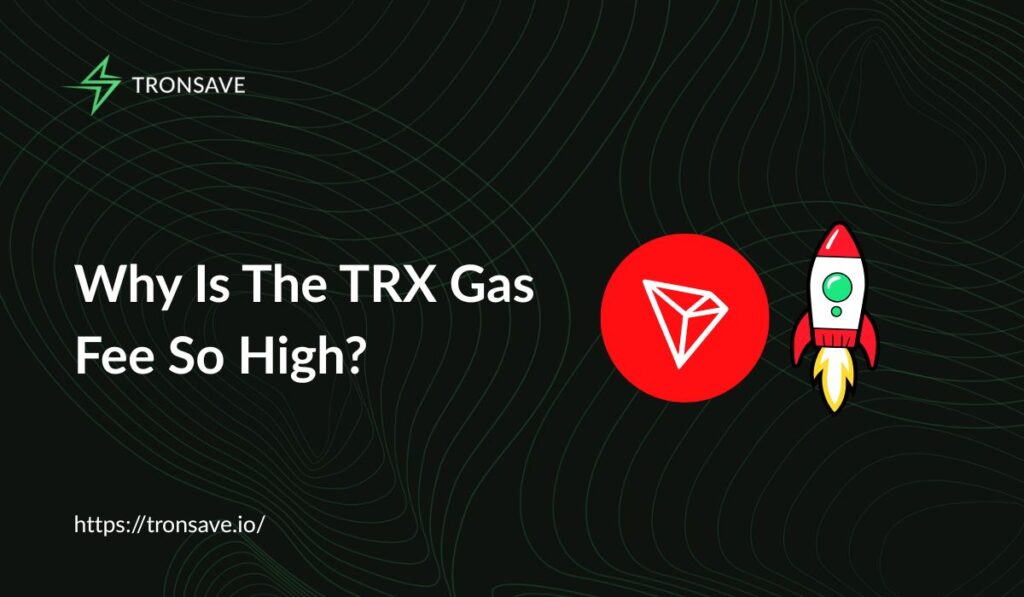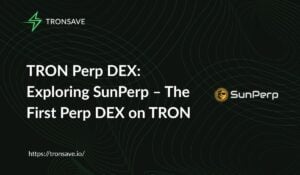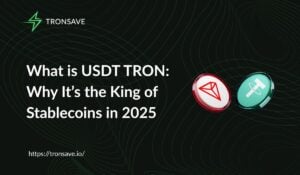
Understanding TRX gas fee
The TRX gas fee feels high due to TRON’s unique resource model—bandwidth and energy—coupled with surging TRX prices and network demand. Unlike traditional blockchains, TRON burns TRX when resources are insufficient, spiking costs for users, especially for TRC20-USDT transfers. With Tronsave, you can navigate these fees and save significantly. Let’s dive into why these fees are climbing and how to manage them effectively.
TRON, founded by Justin Sun in 2014, is a decentralized blockchain designed for fast, scalable dApps. Its fee structure, while often lower than Ethereum’s, has sparked complaints, like a Reddit user noting a $3 fee for a $5 transfer in 2024. By understanding TRON’s mechanics and market dynamics, we’ll uncover the root causes and offer practical solutions.
Why TRX gas fee are rising
Several factors drive the perception that TRX gas fee is high. From TRON’s resource-based system to external market forces, these elements increase costs, especially for small transactions. Below, we break down the key reasons with tips to optimize your transactions.
TRON’s bandwidth and energy system
TRON’s fee structure relies on bandwidth for basic transactions and energy for smart contracts, like TRC20-USDT transfers. Each account gets 5,000 free bandwidth points daily, but smart contracts often require 20,000–30,000 energy units, which aren’t free. Without enough resources, TRX is burned, leading to fees of $3–$8 per transfer, as seen in Reddit threads from December 2024. For example, a TRC20-USDT transfer burns 345 bandwidth points and variable energy, inflating costs when resources are low.
Key Insight: Lack of bandwidth or energy forces TRX deductions, making fees feel exorbitant when TRX’s price is high.
Surging TRX market price
TRX’s price soared to $0.35 in late 2024, per The Currency Analytics, directly impacting fees. Since fees are paid in TRX (e.g., 13.74–27.6 TRX for USDT transfers), a higher TRX value raises USD costs. A $5 transfer costing 13.74 TRX at $0.35 equals $4.81—nearly the transfer amount. This price surge, driven by TRON’s growing transaction volume, amplifies the perceived cost of fees.
Network congestion and demand
TRON’s transaction volume doubled in 2024, according to Cryptomus, straining network resources. High demand, especially for TRC20-USDT, increases energy consumption, pushing fees up for users without staked TRX. During peak times, like late 2024 when Tether data showed soaring fees, users faced costs that shattered TRON’s “low-fee” reputation, as noted by Binance.
Smart contract complexity
Smart contracts, like those for TRC20-USDT or staking, consume more energy than simple TRX transfers. Ledger Support explains that complex dApps can require significant resources, driving fees higher. For instance, a single USDT transfer may burn 345 bandwidth points and 20,000–30,000 energy units, depending on the contract’s demands, making fees feel disproportionate for small transactions.
Comparison with other blockchains
TRON’s fees are often lower than Ethereum’s ($5–$50) or Bitcoin’s ($2–$20 without Lightning Network), as per Breet. However, for small transfers, TRX fees seem high relative to the amount sent. Tronsave’s tools, like energy rentals, can reduce costs to $0.40 per transfer, offering a competitive edge.
How to reduce TRX gas fee with Tronsave
You don’t have to accept high TRX gas fee. Tronsave provides actionable ways to cut costs while maintaining TRON’s speed and reliability. Here’s how to save, with step-by-step guidance tailored to TRON’s resource model.
Freeze TRX for bandwidth and energy
Freezing TRX grants free bandwidth or energy, reducing the need to burn TRX for fees. Staking 6,239 TRX (≈$1746 at $0.28/TRX) provides 64,000 energy units, enough for multiple USDT transfers. Tronsave’s wallet simplifies this process:
- Create or import a TRON wallet on Tronsave’s website.
- Choose bandwidth or energy based on your needs (e.g., energy for USDT transfers).
- Confirm and wait for resources to allocate (instantly available).
This locks TRX for 14 days but saves up to 75% on fees long-term, ideal for frequent transactors.
Rent energy through Tronsave
Renting energy via Tronsave is a cost-effective alternative, with a single USDT transfer costing just 5.22 TRX. This saves 75% compared to standard fees (13.74–27.6 TRX). To rent energy:
- Open Tronsave’s website and navigate to “Buy Energy.”
- Select “Energy” for one transfer or “Fast Trading” for custom amounts.
- Pay 5.22 TRX for 64,000 energy units, valid for one hour.
- Complete your transfer with minimal fees.
This method suits users avoiding long-term TRX staking, offering flexibility and savings.
Use Tronsave’s fee calculator
Tronsave’s fee calculator, similar to Tronscan’s, estimates costs before you transfer. Input your transaction type (e.g., TRX or TRC20-USDT) and check required bandwidth/energy. This helps you plan and avoid unexpected fees, especially during network congestion.
Optimize transaction timing
Avoid peak network times, like late evenings when USDT transfers spike. Scheduling transactions during off-peak hours reduces energy demands, lowering fees. Tronsave provides real-time network status updates to help you time transfers effectively.
Comparing TRX fees to alternatives
To contextualize TRX fees, let’s compare them with other blockchains, including updated Ethereum fee data for accuracy.
|
Blockchain
|
Average Fee (USD)
|
Speed
|
Key Factor
|
Tronsave Savings
|
|---|---|---|---|---|
|
TRON (TRX)
|
$0.40–$8
|
Seconds
|
Bandwidth/Energy
|
Up to 75%
|
|
Ethereum
|
$0.50–$50
|
Minutes
|
Gas market demand
|
Not applicable
|
|
Bitcoin
|
$2–$20
|
Hours
|
No Lightning Network
|
Not applicable
|
|
Solana
|
$0.01–$0.10
|
Seconds
|
Fixed low fees
|
Less competitive
|
Ethereum’s average fee is ~$0.50 for simple transfers (21,000 gas units at ~20 Gwei, per Etherscan), but complex transactions (e.g., DeFi, NFTs) can hit $10–$50 during congestion, per Trakx. TRON’s fees are competitive but feel high for small transfers. Tronsave’s energy rentals reduce costs to as low as $0.40, offering significant savings.
Common myths about TRX gas fee
Misconceptions about TRON’s fees can confuse users. Let’s debunk a few and clarify how Tronsave addresses them.
- Myth: TRX fees are always low.
Reality: Fees vary based on resources and TRX price. Tronsave’s tools ensure affordability. - Myth: You can’t transfer USDT without TRX.
Reality: With sufficient bandwidth/energy or Tronsave’s subsidies, you can minimize or eliminate TRX costs. - Myth: Fees are fixed across all transactions.
Reality: Smart contracts (e.g., TRC20-USDT) cost more than TRX transfers. Tronsave’s fee calculator helps you plan.
FAQ: Common questions about TRX gas fee
1. Why are TRC20-USDT fees higher than TRX transfers?
TRC20-USDT involves smart contracts, consuming both bandwidth and energy, unlike TRX transfers that only use bandwidth.
2. Can I send USDT without TRX?
Not directly, but Tronsave’s zero-fee subsidies or sufficient bandwidth/energy can eliminate TRX deductions.
3. How does TRON compare to Ethereum for fees?
4. Is staking TRX worth it?
Yes, staking 1,980 TRX saves up to 75% on fees by providing energy for multiple transfers.
5. How can I track TRX fees?
Use Tronsave’s fee calculator or Tronscan to estimate costs based on transaction type and network conditions.
6. What’s the cheapest way to transfer USDT on TRON?
Rent energy through Tronsave for $0.40 per transfer or claim zero-fee subsidies when available.
Conclusion
High TRX gas fee arise from TRON’s bandwidth and energy model, soaring TRX prices, and network congestion, but Tronsave offers practical solutions to save up to 75%. Freeze TRX, rent energy, or join zero-fee campaigns to keep costs low while enjoying TRON’s speed. Don’t let fees hold you back—download Tronsave’s app, explore its fee calculator, and start optimizing your transactions today. Visit Tronsave for tools and guides to make your TRON experience seamless and affordable.



